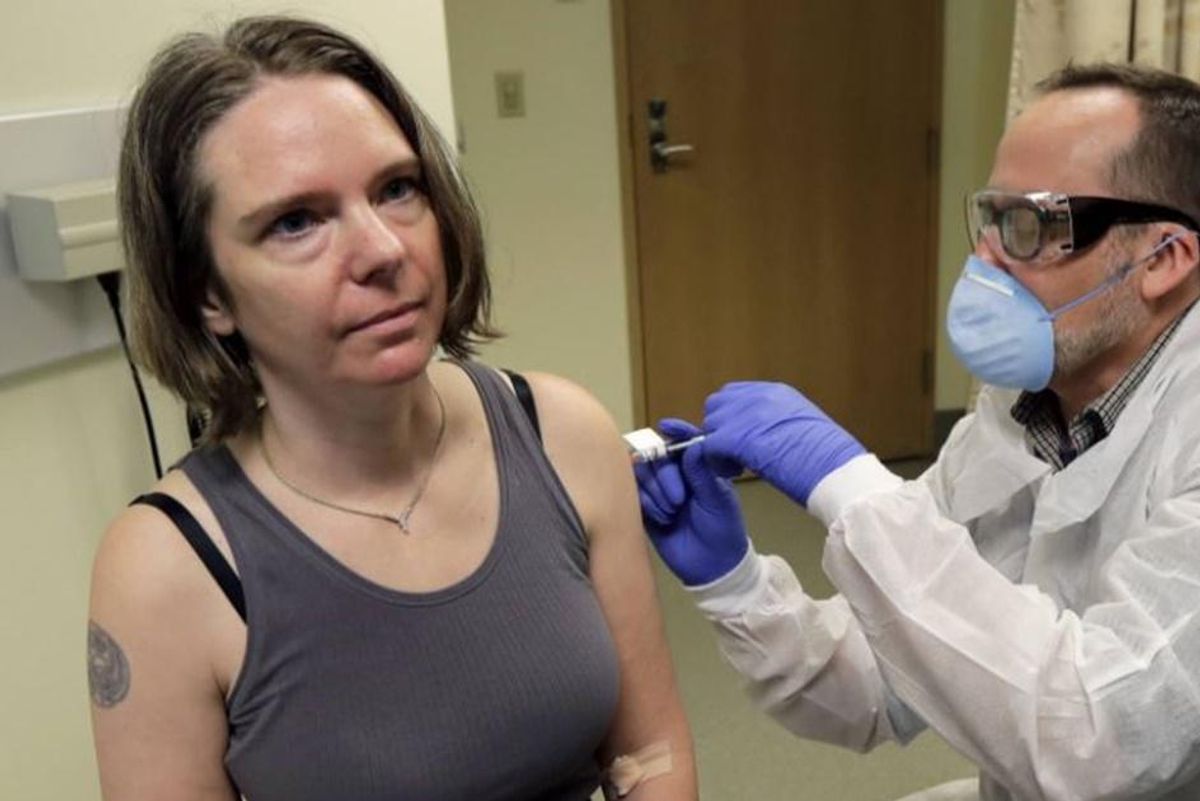We talked with the first American to get the COVID-19 vaccine and she'll put you at ease

While the arrival of multiple COVID-19 vaccines has made people feel hopeful about the future, many are still leery about getting the shot.
A recent poll by Pew Research found that "60% of Americans say they would definitely or probably get a vaccine for the coronavirus if one were available today." That figure is 9% higher than when the same question was asked in September.
Four in ten people (39%) say "definitely or probably would not get a coronavirus vaccine" although half of them say they may change their mind after the vaccine is widely administered.
If you're feeling a little iffy about getting vaccinated it doesn't make you an anti-vaxxer. It's natural to be a little skeptical of something that was developed so rapidly. So, to ease your mind about getting vaccinated, our partners at Leapsmag spoke with Jennifer Haller, the first person in the U.S. to receive COVID-19 vaccine.
Jennifer is a mother of two from Seattle, Washington who was administered the vaccine back in March and, as you can tell by the video, she's happy and healthy nine months later.
Jennifer received the Moderna vaccine which requires two shots administered four weeks apart.
After receiving both, Jennifer says she felt just like she has after any other vaccination. "I've had a flu shot before, I've had other vaccinations before, this is just another one of those," she said. "Everything's going to be fine. And it was."
Jennifer didn't know she was going to be the first person to receive the vaccine. She put two and two together after reading an AP report the night before her vaccination saying the first vaccine was going to be administered the next morning. Her appointment was at 8 am.
"I'm like, oh gosh, that might actually be me," she said.
The only side effect she experienced from taking the vaccine was some soreness at the injection site after both doses. "Besides that, everything else felt very normal," she added. "I'm feeling great. everything feels perfectly normal and my life is just as normal as everyone else's is right now."
Jennifer says that after receiving both doses, tests showed the vaccine was effective in creating COVID-19 antibodies. She says the first eight recipients of the Moderna vaccine all developed antibodies at the same level or above someone who has recovered from the virus.
She believes she was the right person to go first because of her attitude.
"To be one of the first, I think it really requires somebody like me who's really positive, who expects good things to happen, and somebody who trusts science," she said.
For Jennifer, stepping up to be the first was about more than just protecting her health and that of others.
"I want to stay conscious of the privilege I have in life and I want to use it to help others," she said. "I'm very thankful that I have the opportunity to do that and I hope that it inspires others to consider the privilege they have in their lives and to look at ways they can use that as well to help."
Jennifer hopes that people approach this as a health issue, not a political one. "It is not a political statement," she said of getting vaccinated. "It's not political, it's about saving lives."
For those who have decided against getting the vaccine, Jennifer suggests they reconsider.
"Science is real. It's a fact. It works," she said.
- Let's take a moment to honor the unsung Moderna vaccine trial ... ›
- The science deniers are losing: Support for immunization jumps in ... ›
- Coronavirus vaccine trials begin as first volunteers receive shots ›
- Vaccine skeptics are my people. Here's how to reach at least some of us. - Upworthy ›
- Vaccine skeptics are my people. Here's how to reach at least some of us. - Upworthy ›
- Americans, please take Luke Letlow's death as the cautionary tale that it is - Upworthy ›
- Oregon healthcare workers stuck in the snow vaccinated random drivers while they waited - Upworthy ›
- Johnson & Johnson's vaccine news proves it's vital to read articles and not just headlines ›
- A Chick-fil-A manager revolutionized this town's COVID vaccination waiting times - Upworthy ›
- Great news: More Americans have now been vaccinated against COVID than have been infected - Upworthy ›
- No one is safe until everyone is safe: the continued cost of a global pandemic ›
- Ben Franklin had to deal with anti-vaxers during smallpox - Upworthy ›
- Here's how to handle needle fear so you can be vaccinated - Upworthy ›
- Employers re considering docking people's pay if they are unvaccinated. - Upworthy ›
- Fact check: The CDC is not mandating COVID vaccines in kids - Upworthy ›
- Fact check: The CDC is not mandating COVID vaccines in kids - Upworthy ›

